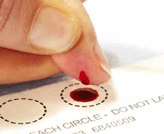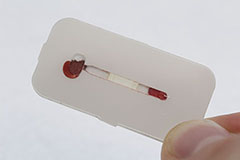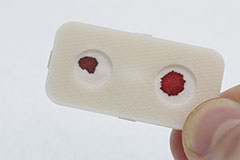Dried Blood Spot sampling
Dried Blood Spot (DBS) sampling is a blood collection technique which typically uses a small droplet of blood directly from a fingerprick.

The droplet is collected on a special paper substrate and dried, thus forming the DBS. For the analysis, a small paper disk is punched out from the DBS, carrying an undefined portion of blood. Minimal invasive sampling, low sample volume and easy sample handling and storage are the key advantages of this sampling method over traditional sampling methods. These advantages make DBS sampling a high potential alternative to traditional sampling methods. However, when concentration in blood needs be measured, the solid sample nature is a problem: Unknown volume and the distorted composition in DBS samples are limiting the accuracy of the analysis. Therefore, we are currently developing a new sampling device, using microfluidic technologies to overcome the problems of unknown volume and sample distortion by pre-defining the sampled volume before storing it in the paper. This would enable the use of DBS in different fields, e.g. for therapeutic drug monitoring (TDM) where DBS sampling would be beneficial for the patients, the quality of data that can be produced and at the same time allow to safe costs in healthcare. In the future, blood sampling could even be done at the patient’s home using the DBS chip to produce high quality volume defined DBS samples which can simply be sent to the clinic by conventional mail and thereby ease feedback from the clinic to the patients.

|

|
Project sponsors:
- Stockholm County Council
Project partners:
- Karolinska University hospital, Profs. Olof Beck & Lars L Gustafsson
